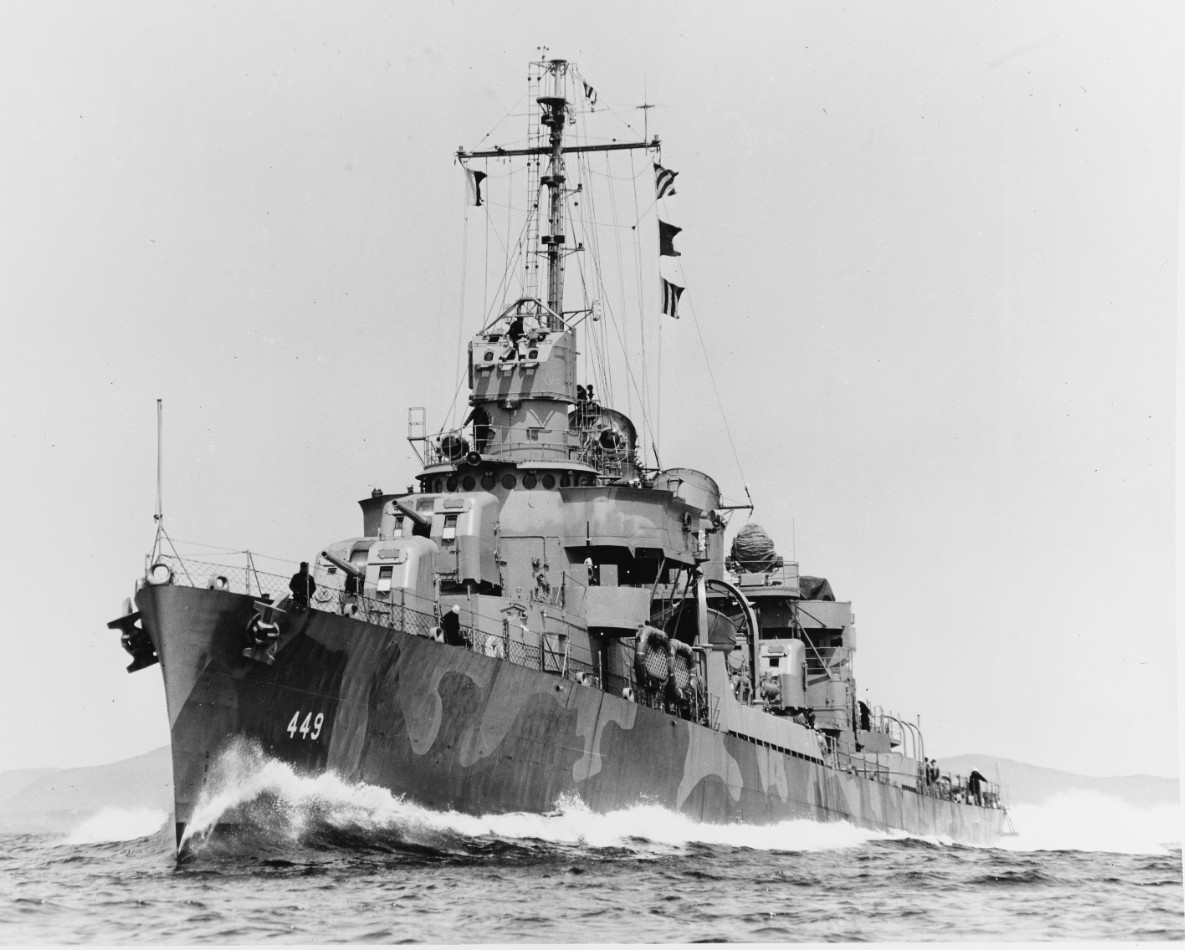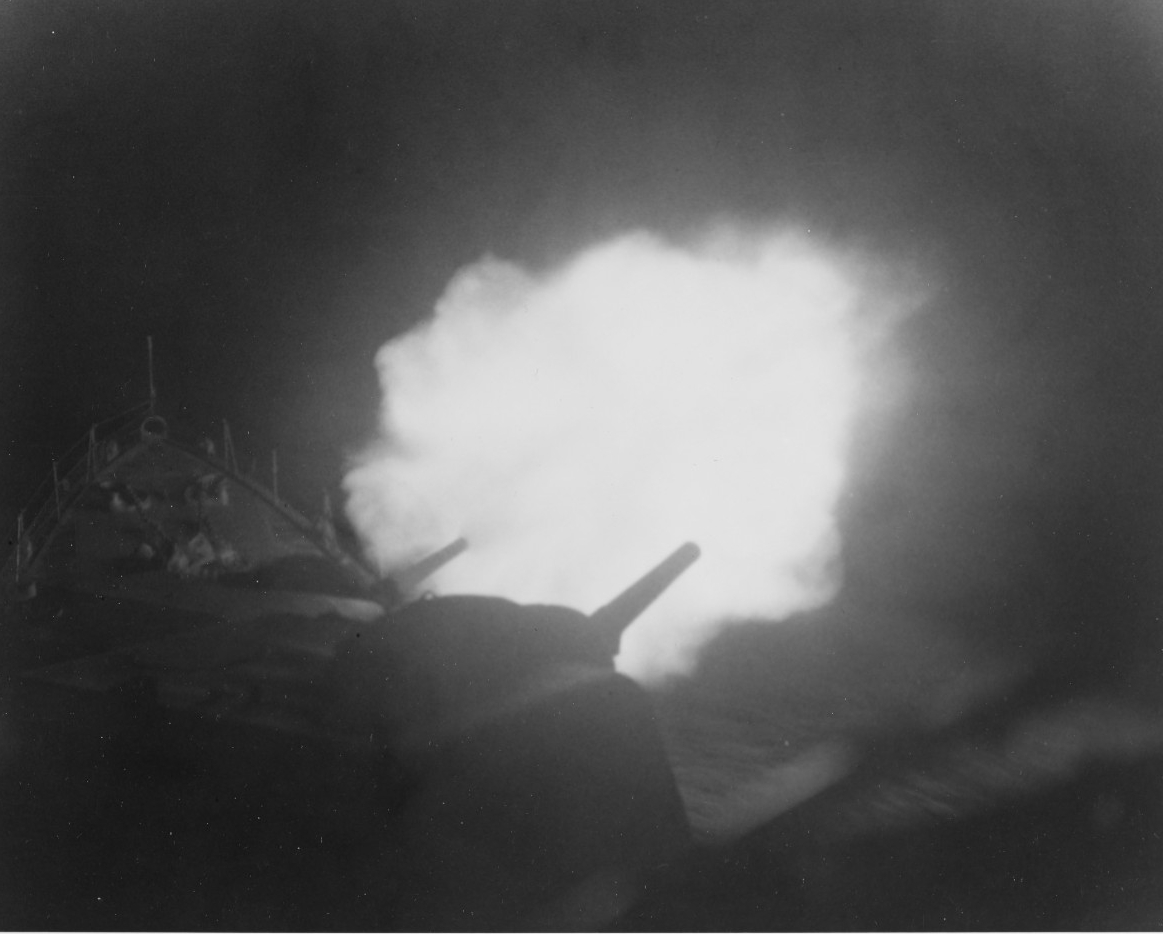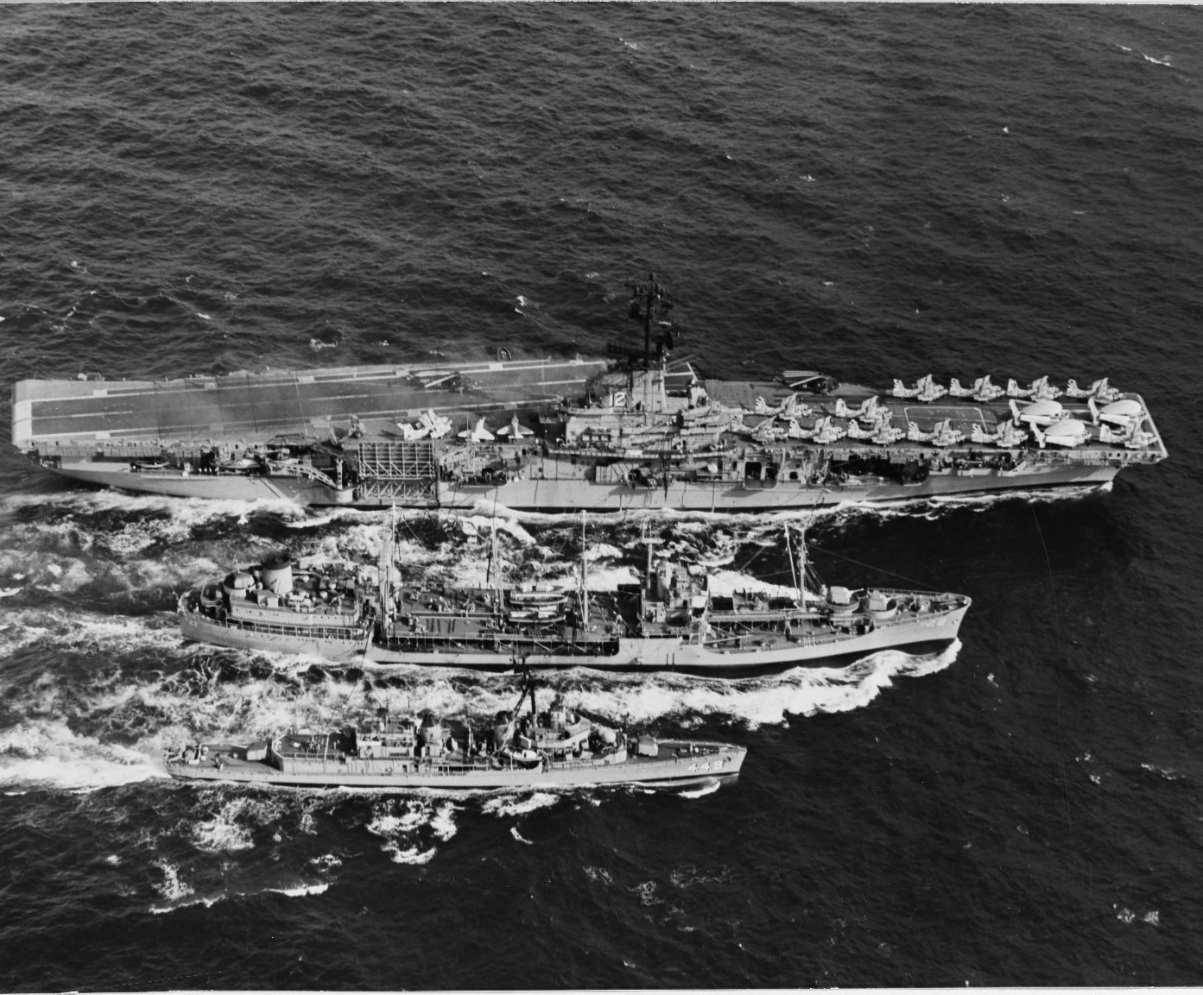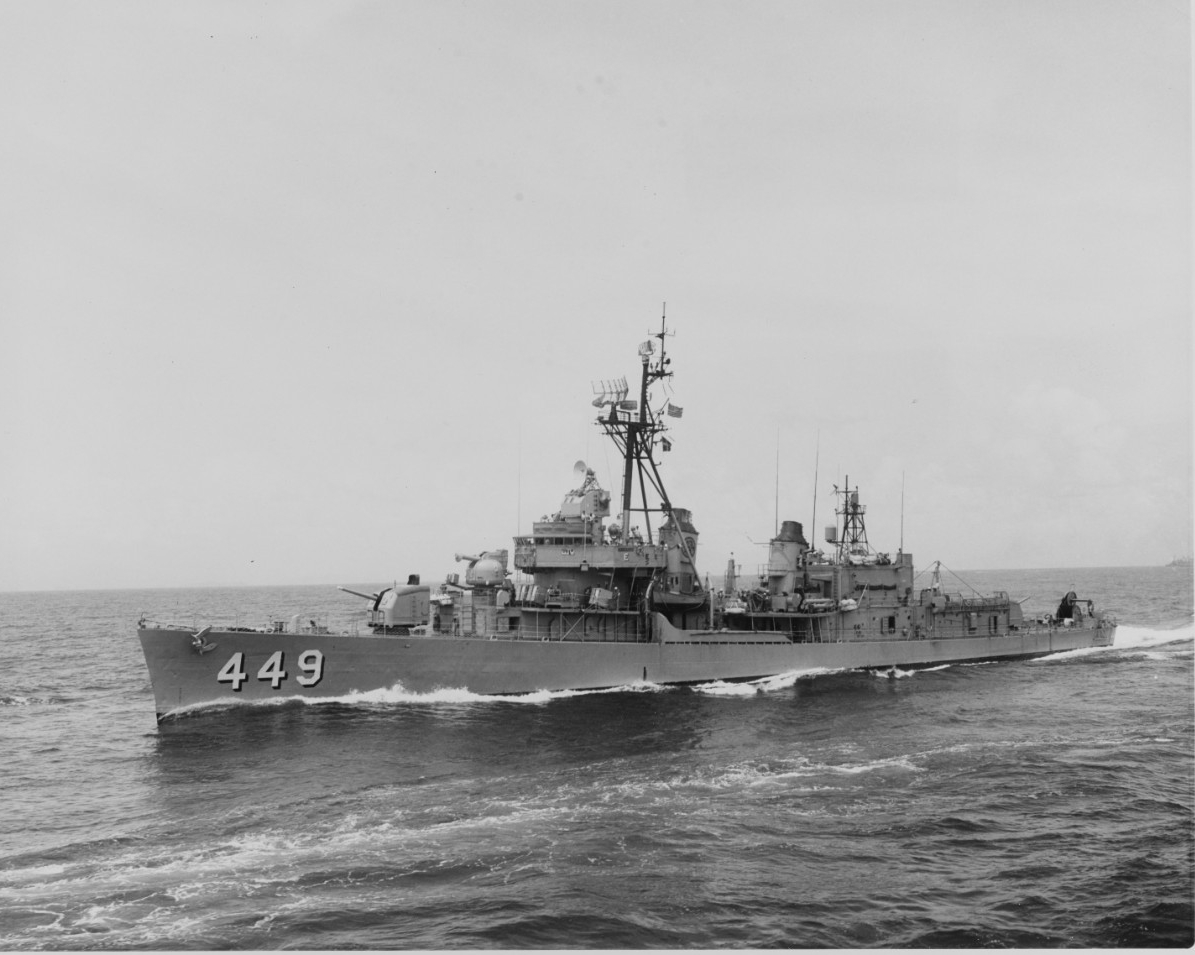Nicholas II (DD-449)
(DD-449: dp. 2,050; l. 376-6-; b. 39- 8-; dr. 17- 9-; s. 37 k.; cpl. 319; a. 5 5-, 10 40mm., 10 21-tt., 6 dcp., 2 dct., cl. Fletcher)
Samuel Nicholas was born in Philadelphia, Pa., in 1744 and received his commission as Capt. of Marines from the Continental Congress on 28 November 1775. He joined Continental Ship Alfred as Marine Officer at her commissioning on 3 December. On 3 March 1776, he commanded the first amphibious landing of American Marines when the Continental Fleet under Commander in Chief Esek Hopkins attacked New Providence in the Bahamas. Leading a party of 200 Marines and 50 Sailors, Nicholas captured Fort Montague, Government House, and Nassau. The capture of New Providence brought badly needed cannon and ammunition to the hard-pressed Continental Army. Promoted to major on 6 June 1776, Nicholas trained Marines for duty at sea and in the field with Gen. George Washington, becoming virtually Commandant of Marines, although such a title did not then exist. He died in Philadelphia on 27 August 1790.
II
The second Nicholas (DD-449) was laid down 3 March 1941 by the Bath Iron Works Corp., Bath, Maine; launched 19 February 1942; sponsored by Mrs. Edward B. Tryon, descendant of Major Samuel Nicholas; and commissioned 4 June 1942, Lt. Comdr. W. D. Brown in command.
Destined to serve in the Pacific through three armed conflicts, Nicholas, assigned to DesRon 21, departed New York City 23 August 1942, sailing in the screen of Washington (BB-56), transited the Canal, and continued on to the Central Pacific, arriving at Espiritu Santo 27 September. Three days later she began escorting Guadalcanal bound troop and supply convoys. Into 1943, she screened the convoys assembled at Espiritu Santo and Noumea to "Cactus" area, Guadalcanal and Tulagi, guarded them as they off-loaded and then returned the vessels to their departure point. Periodically assigned to offensive duties, she also conducted anti-submarine hunterkiller missions off Allied harbors, sweeps of the "Slot," bombarded shore targets and performed gunfire support missions for Marine and Army units as they pushed toward the Tenamba River and total control of the long embattled island.
In January 1943, Nicholas was one of the Tulagi based, "Cactus Striking Force" (TF 67) destroyers which resisted the Japanese last counterattack for Guadalcanal by pounding the newly built enemy air facilities at Munda (4-5 January); shelling their Kokumbona-Cape Esperance escape route (19 January); and blasting their Munda resupply area at Vila on Kolombangara (23-24 January).
On 1 February, as the Japanese began operation -KE-, the evacuation of Guadalcanal, Nicholas covered the 2nd Battalion, 132nd Infantry landing at Verahue and supported them as they began their trek inland to seal off the Cape Esperance area to Japanese reinforcements. Enroute back to Tulagi, Nicholas, with DeHaven (DD-469) and 3 LCTs, was attacked by a formation of 14 "Vals." Three bombs hit DeHaven and a fourth, a near miss, holed the hull. As her sister destroyer settled in the waters of Ironbottom Sound, Nicholas fought off eight planes, receiving only near misses which killed two of her crew and damaged the steering gear.
Following repairs, Nicholas resumed her varied duties. Escort assignments and two bombardments of the MundaKolombangara area of New Georgia took up March. In April, she joined TF 18 for "Slot" patrol and on the 19th turned her bow toward Australia for an availability at Sydney. By 11 May she was once again with TF 18 enroute to Kolombangara. On the 13th, while firing on enemy positions there, her #3 gun jammed and exploded, with no casualties. After repairs at Noumea, she took up anti-submarine patrol duties and at the end of the month resumed escort duties in the Solomons-New Hebrides area.
On 5 July she participated in another bombardment of Kolombangara. In the early morning hours of the 6th she made contact with enemy surface vessels in Kula Gulf. In the ensuing battle, Helena (CL-50) was lost. Nicholas, while rescuing 291 survivors, took the Japanese ships under torpedo and gunfire. She was later awarded the Presidential Unit Citation for her persevering performance during the Battle of Kula Gulf.
On the 12th and 13th she participated in the Battle of Kolombangara; on the 15th covered the rescue of remaining Helena survivors from Vella LaVella; and on the 16th returned to Tulagi to resume escort duties. In early August, she joined T.U. 31.5.1 and on the 15th screened the advance transport group during landings on Barakoma, Vella LaVella. Back at Tulagi on the 17th, she, with O-Bannon (DD-450), Taylor (DD-468), and Chevalier (DD-451), was sent out to intercept four Rabaul based Japanese destroyers as they headed for Vella LaVella to cover the establishment of a barge staging area at Horaniu.
Racing up the "Slot," the American destroyers picked up their Japanese counterparts on surface radar at 0029, 18 August, 113/2 miles away. To the west the radar showed a barge group. At 0050, the American quartet feinted toward the barges. At 0056, they swung back toward the Imperial Navy's destroyers, now 5 miles to the northwest. The brief engagement off Horaniu, in which the Japanese "crossed the T" of the American forces but failed to press their advantage, was broken off by the Japanese at 0103. The American force pursued, scored on Isokaze, and finally dropped behind, engineering problems in Chevalier limiting them to 30 knots. They then turned their attention to the scattering barge group, destroying 2 subchasers, 2 motor torpedo boats and one barge.
Nicholas returned to Vella LaVella on 19 and 20 August to conduct barge hunts and on the 24th and 25th to cover mine operations. At the end of the month she steamed to Noumea, thence to New Guinea and Australia. Back in the Solomons by October, she conducted another search for barge traffic and on the 6th covered the unloading of APDs at Barakoma. Then, 22 October, she steamed to Efate to resume escort duties.
On 11 November Nicholas departed Nandi, Fiji Islands, with TG 50.1 for raids on Kwajalein and Wotje, after which she headed east, arriving at San Francisco 15 December for overhaul. On 12 February 1944 she resumed Central and South Pacific escort duties. On 5 April she proceeded, with DesRon 21, to Milne Bay for temporary duty with the 7th Fleet. On the 22nd, she covered the Aitape landings, and until 8 May escorted resupply groups there and to Humboldt Bay. She then returned to the Solomons and the 3d Fleet, shelling Medina Plantation, New Ireland, on the 29th. Spending the first part of June on anti-submarine patrol, she again joined the 7th Fleet on the 14th, serving with TG 70.8 in the northern Solomons. On 15 August she sailed to Manus to join TF 74 and until the 27th operated along the New Guinea coast. She then returned to Seeadler harbor whence she supported the Morotai operation 15-30 September.
On 18 October, the destroyer, now in TG 78.7 escorted reinforcements to Leyte, arriving on the 24th. On the 25th and 26th, she patrolled off Dinagat Island and on the 27th set out again for Manus. On 8 November she sailed for Ulithi, whence she headed for Kossol Roads. Enroute to the latter, her three ship formation, Taylor and St. Louis (CL-49), was closed by a submarine, 12 November. Leaving the formation. Nicholas pressed home 2 depth charge attacks, sinking I-38, Four days later, Nicholas joined TG 77.1 on continuous patrol of the southern end of Leyte Gulf. There until 6 December, she survived 4 attacks by suicide plane formations, 27 and 29 November and 2 and 5 December. On 6 December she assisted in a sweep of the Camotes Sea, bombarded Japanese Naval facilities on Ormoc Bay and then covered Allied landings there. On the 10th she sailed for Manus, returning to Leyte on the 28th for further escort work.
On the first day of the new year, 1945, the destroyer joined TG 77.3, the Close Support Group for the Lingayen Gulf assault. Enroute to Luzon, her group was harassed by enemy midget submarines and almost constant air raids. After a 2 day bombardment, Army troops landed 9 January. Until the 18th Nicholas provided fire support; then patrolled to the west of Luzon with the covering escort carrier group. On the 24th she captured a motor boat being used by 3 Japanese to escape from the island and on the 29th provided close cover for the landings in Zambales Province.
During the first part of February she escorted vessels between Leyte and Mindoro, whence she proceeded to Manila Bay to shell Corregidor, other islands in Manila Bay, and shore installations at Mariveles. Resuming escort work on the 17th, she guarded mine sweepers as they cleared Basilan Strait in mid-March and then supported the occupation of the Zamboanga area. In April. she returned to Luzon to support the 6th Army as it fought to reoccupy the island and then on the 24th resumed operations in the Netherlands East Indies. From then until 5 May she supported the Tarakan operation, after which she steamed north again to Luzon, thence to Leyte where she joined TU 30.12.2 and departed for Okinawa, 15 June. Following strikes on Sakishima, she joined TG 30.8 at Ulithi and screened that group as it refueled and resupplied the fast carriers at sea. On 11 August she reported to CTG 38.4, a fast carrier group, and on the 13th screened the flattops during strikes against the Tokyo area. On the 15th hostilities ceased.
Nicholas transported Allied and U.S. representatives to the formal surrender on Missouri (BB-63) 2 September, and then joined in the repatriation of Allied POWs. Departing the Far East 5 October, she arrived at Seattle on the 19th and continued on to San Pedro, arriving 1 November to begin inactivation. Decommissioned 12 June 1946, Nicholas remained in the Pacific Reserve Fleet until hostilities in Korea necessitated her recall. Reclassified DDE-449, 26 March 1949, she was brought out of reserve to begin conversion in November 1950. Recommissioned 19 February 1951, she underwent shakedown off the west coast; steamed to Pearl Harbor where she joined CortDesDiv 12, CortDesRon 1; and continued on to the Western Pacific, arriving at Yokosuka 10 June. In Far Eastern waters until 14 November, she screened the carriers of TF 77 off the west coast of Korea; conducted ASW exercises between Yokosuka and Okinawa; and patrolled the Taiwan Strait. On 3 May 1952 she departed Pearl Harbor again for Korea. A temporary replacement vessel in DesDiv 112, she served first with TF 77 and then swung around the peninsula to the gunline off the Korean east coast and operated there, under CTF 95, until sailing for home in July. She returned to Korea with CortDesDiv 12 in November and remained in the Far East until 20 May 1953 performing missions similar to her 1951 deployment.
After Korea, Nicholas rotated duty in WestPac with 1st Fleet assignments. Her 7th Fleet deployments took her from Japan to Sumatra, while EastPac assignments ranged primarily from Hawaii to the west coast. On occasion 1st Fleet duty sent her to the Central Pacific as in 1954 when she assisted in operation "Castle," an atomic test series.
Modernized between December 1959 and July 1960, Nicholas emerged from the shipyard in time for her annual rotation to WestPac, which, that year, sent her, for the first time since World War II, to the South China Sea for extensive operations. Reclassified DD-449 on 1 July 1962, she returned to the South China Sea in March 1965. There she became one of the first ships engaged in operation "Market Time," patrol of the jagged South Viet Namese coastline to prohibit smuggling of men, weapons, and supplies into South Vietnam by Viet Cong and North Vietnamese junks and sampans.
Relieved of duty 15 April, Nicholas returned to Pearl Harbor only to depart again for Vietnam in mid-September. Off the embattled coast by 1 October, she carried out surveillance assignments and gunfire support duties until 3 December, when she proceeded to Taiwan for patrol duty in Taiwan Strait. Early in 1966 she returned to Viet Nam for duty on "Yankee Station" in the Gulf of Tonkin, followed by another tour on "Market Time" patrol. Homeward bound at the end of February, she proceeded to Australia, thence to Hawaii, arriving 17 March.
Each WestPac tour since that time has followed a similar employment schedule. Her gunfire support missions during her November 1966-May 1967 tour included participation in operation "Deck House V" in the Mekong Delta area, as well as missions close to the DMZ. Most of her 1968 tour was again spent in Vietnamese waters, this time, however, with a greater portion spent on "Yankee Station" and on gunfire support missions.
On her return to EastPac in 1968, Nicholas was assigned to support NASA's Apollo Program. From 8 to 23 October and again between 19 and 22 December she operated in the Pacific space capsule recovery areas; first for the Apollo 7 mission, then for Apollo 8. After each of these assignments she has returned to Pearl Harbor for training exercises in Hawaiian waters in preparation for a return to the Western Pacific.
Nicholas earned 16 battle stars in World War II and 5 in the Korean Conflict.
Nicholas (DD-449) underway at sea in June 1964. Nicholas is fitted during her 1960 FRAM II modernization, with new smokestack caps and a DASH drone helicopter hangar and flight deck. Photographer: PH1 T.J. Meade. Official U.S. Navy photograph, from the collections of the Naval History and Heritage Command. NH 107294






